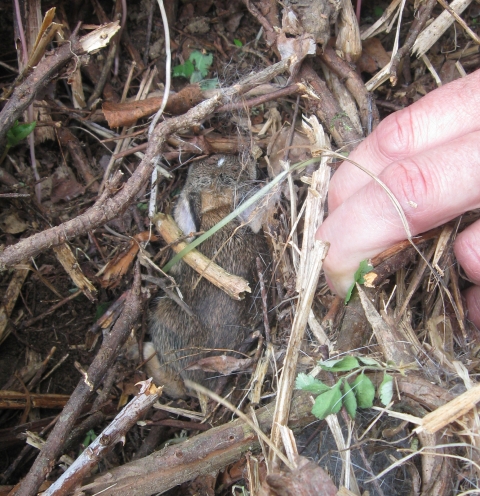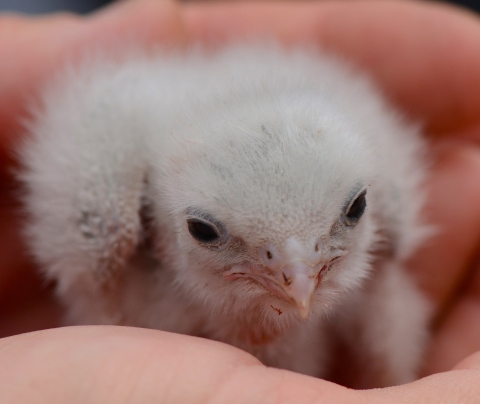All too often the refuge gets phone calls starting out something like this, “I have found an abandoned baby/hurt animal! What do I need to do with it?” Then sometimes we have to give an answer that’s not what people were expecting. In most cases, the best answer is to place the animal back where you originally found it. Many times a baby animal is not abandoned, but hiding from predators while mom is off feeding. Refuge staff are not licensed rehabbers and do not have the necessary equipment, a truly injured or abandoned animal must go to a licensed rehabber.
Baby deer are commonly found alone in late May or early June. For the first several weeks of their life, if they feel threatened, their instinct is to drop to the ground and curl up in a ball and remain very still. The spots help to camouflage them from predators. So, if you do come across a spotted fawn, please do not assume that it has been abandoned, just leave the area quietly without touching it. You can rest assured that mom is not far away and keeping a good eye on the fawn. If the fawn is walking around, constantly crying, and is showing signs of dehydration, call a wildlife rehabber. Contact the rehabber (links at the bottom of the page) or the State wildlife agency BEFORE moving the fawn, or any injured deer. There are new state regulations regarding transportation and rehabilitation of deer due to disease surveillance.
Eastern cottontails leave their young for long periods of time as well. In fact, some might say they are lousy parents. The mother leaves the young all day only returning at night briefly to feed between dusk and dawn. One way to see if the babies are truly abandoned is to do a flour test. Sprinkle a circle of flower around the nest and check for tracks the next morning. If the nest has been destroyed, maybe by a lawnmower or a pet, you can always build a new at that same location. The mother will not mind and will still care for her young. If you need to keep your pets out of the nest, turn a laundry basket, with a hole cut in the side for mama to enter and leave, upside down and place bricks on top. When cottontails are 5-6 inches long (the length of a dollar bill) they are fully independent and should be left alone.
Squirrels often fall out of their nest, but mother squirrels do not abandon their young so easily. If you see the nest is destroyed, again, leave the babies be. The mother will have a second nest built and be soon retrieving the babies. If you are concerned for their safety, such as if there are dogs/cats close, you can place the babies in a basket and hang it in the tree.
Another common phone call to the Refuge is about baby birds on the ground. If the baby bird doesn’t have many feathers and is too small to fly, simply locating the nest and placing the baby back in it, is the very best thing you can do. If the nest is too high or has been destroyed you can hang a grass-lined basket or plastic container (with holes in the bottom) as close to the old nest as you can get. Make sure to keep a good a distance from the location (people and pets) to allow the mother's return. Despite the old saying, “Once you touch a baby bird the mom will smell it and never care for it again,” most birds can’t smell and mom will be very happy to have her baby back.
If the baby bird can fly, maybe just not very good and is mostly hopping, again the best thing for it is to be left alone. This is a fledgling and usually at this point both parents are close by keeping a watch for predators. If you have pets it’s best to keep them away from the area until the baby has flown away. It usually only takes a day or two for baby birds to really get a handle on flying, after all they are birds and that’s what birds do.
Turtles should always be moved across roadways in as direct a line as possible. Never, relocate a turtle to a “safer” place miles away. They will travel back to where you found them and possibly encounter more danger. For small turtles, such as Eastern Box Turtles, gently and firmly grasp the turtle’s sides with both hands. Think of holding it like you would a large sandwich, and move it across the road the direction it was headed. Snapping turtles are larger and can be more reluctant to receive help, this requires a different plan. Place a car mat, piece of cardboard, or a towel in front of it and encourage it to climb aboard with a few gentle nudges. Once they are on the mat, drag it the rest of the way across the road, and let the turtle walk off. Signs of injury that would need a rehabber (links at the bottom of the page) include a cracked or fractured shell with blood on the shell or on the ground, or a turtle with blood around its mouth.
Opossum are unique in that they enter a catatonic state when they are threatened by a predator such as your dog. This defense mechanism is intended to confuse its attacker and allow the possum to escape. Unless there is an obvious injury, give the opossum plenty of time and space to wake up. Opossums are marsupals, meaning they have a pouch to hold their babies. It is common to find a dead female with live babies. If this happens, there is no need to extract the babies. Place the mother in a box and contact a wildlife rehabber (links at the bottom of the page). They will remove the babies from the mother, and can ensure that no babies are overlooked or left behind. Young opossums seven inches or longer should be left alone unless they are noticeably injured.
If there is a genuine case of an abandoned animal or an injured animal, they must go to a rehabber. These are people that have received proper training and certification to handle and care for wildlife. They do their very best to get wildlife healthy, allowing the animal to be returned to the wild.
Animals are cute, and it's good to have a desire to help, but it’s not good for wild animals to be subject to unnecessary human intervention or be kept as pets for several reasons. First, it is not legal. Depending on what state you live in, permits are required to possess wildlife or it might not even be allowed at all. Secondly, wild animals are meant to be wild and free. Sometimes even if animals are given proper care they become too dependent on people and can never be released to their natural habitat.





